NISSAN PULSAR 1987 Workshop Manual
Manufacturer: NISSAN, Model Year: 1987, Model line: PULSAR, Model: NISSAN PULSAR 1987Pages: 238, PDF Size: 28.91 MB
Page 161 of 238
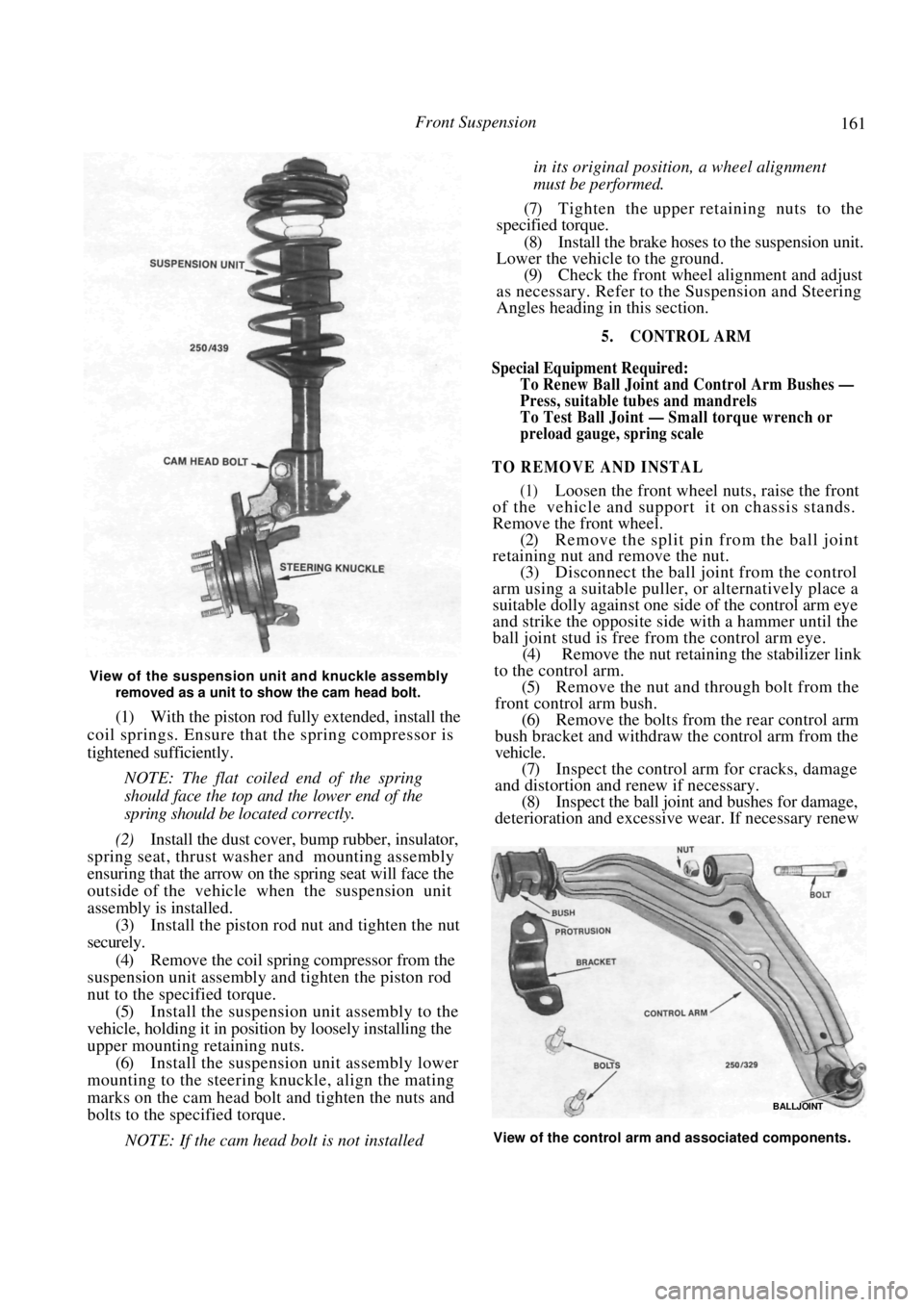
Front Suspension 161
View of the suspension unit and knuckle assembly removed as a unit to show the cam head bolt.
(1) With the piston rod fully extended, install the
coil springs. Ensure that the spring compressor is
tightened sufficiently.
NOTE: The flat coiled end of the spring
should face the top and the lower end of the
spring should be located correctly.
(2) Install the dust cover, bump rubber, insulator,
spring seat, thrust washer and mounting assembly
ensuring that the arrow on the spring seat will face the
outside of the vehicle when the suspension unit
assembly is installed.
(3) Install the piston rod nut and tighten the nut
securely.
(4) Remove the coil spring compressor from the
suspension unit assembly and tighten the piston rod
nut to the specified torque. (5) Install the suspension unit assembly to the
vehicle, holding it in position by loosely installing the
upper mounting retaining nuts. (6) Install the suspension unit assembly lower
mounting to the steering knuckle, align the mating
marks on the cam head bolt and tighten the nuts and
bolts to the specified torque.
NOTE: If the cam head bolt is not installed
in its original position, a wheel alignment
must be performed.
(7) Tighten the upper retaining nuts to the
specified torque.
(8) Install the brake hoses to the suspension unit.
Lower the vehicle to the ground.
(9) Check the front wheel alignment and adjust
as necessary. Refer to the Suspension and Steering
Angles heading in this section.
5. CONTROL ARM
Special Equipment Required:
To Renew Ball Joint and Control Arm Bushes —
Press, suitable t ubes and mandrels
To Test Ball Joint — Small torque wrench or
preload gauge, spring scale
TO REMOVE AND INSTAL
(1) Loosen the front wheel nuts, raise the front
of the vehicle and support it on chassis stands.
Remove the front wheel.
(2) Remove the split pin from the ball joint
retaining nut and remove the nut.
(3) Disconnect the ball joint from the control
arm using a suitable puller, or alternatively place a
suitable dolly against one si de of the control arm eye
and strike the opposite side with a hammer until the
ball joint stud is free from the control arm eye. (4) Remove the nut retaining the stabilizer link
to the control arm.
(5) Remove the nut and through bolt from the
front control arm bush. (6) Remove the bolts from the rear control arm
bush bracket and withdraw the control arm from the
vehicle. (7) Inspect the control arm for cracks, damage
and distortion and renew if necessary. (8) Inspect the ball joint and bushes for damage,
deterioration and excessive wear. If necessary renew
BALLJOINT
View of the control arm and associated components.
Page 162 of 238

162 Front Suspension
the ball joint or bushes as described later in this
section.
Installation is a reversal of the removal procedure
with attention to the following points:
(1) When installing the control arm bush
bracket, ensure that the protrusion on the bracket is
towards the inside of the vehicle.
(2) Do not fully tighten the control arm bush
bolts and through bolt nut until the curb weight of the
vehicle is on the suspension.
NOTE: Curb weight is with the vehicle
unladen except for a full tank of fuel and
normal amounts of oil and water and with
the spare lyre, jack and hand tools in their
normal positions.
(3) Tighten the ball joint nut to the specified
torque and retain with a new split pin.
TO CHECK AND RENEW BALL JOINT
(1) Remove the control arm from the vehicle as
previously described.
(2) Install the ball joint nut and turn the ball
joint at least ten revolutions to ensure that the ball
joint is correctly seated. (3) Using a spring scale with the hook placed
over the split pin hole, check the ball joint swinging
torque. A new ball joint should measure 15.7-80.4 N
and a used ball joint should measure 7.8-80.4 N.
Renew the ball joint if necessary. (4) Using a small torque wrench or preload
gauge, measure the force requi red to rotate the ball
joint. A new ball joint should measure between
1.0-4.9 Nm and a used ball joint should measure
between 0.5-4.9 Nm. Renew the ball joint if neces-
sary.
(5) To renew the ball joint, remove the snap ring
from the stud end of the ball joint using snap ring
pliers. (6) Support the control arm in a press, ball joint
stud uppermost, with a suitable tube that is large
enough for the ball joint to pass through. (7) Press the ball joint out from the control arm.
(8) Press a new ball joint into the control arm
using a suitable tube that pushes on the outer circum-
ference of the joint only.
(9) Install the snap ring and install the
control
arm to the vehicle as previously described.
TO RENEW CONTROL ARM BUSHES
(1) Remove the control arm from the vehicle as
previously described. Mark the position of the rear
control arm bush. (2) To remove the rear control arm bush use a
bearing puller and a press. When installing the bush
use a suitable tube that pushes on the inner edge of the
bush only. NOTE: Ensure that the bush is installed
with the flat portion in its original location.
(3)
To remove the front control arm bush use a
suitable tube that pushes on the outer circumference
of the bush and a split tu be supporting the control
arm. (4) After the bush has been pressed out approx-
imately half way, cut the protruding part of the bush
using a hacksaw. Cutting the bush in this way will
allow removal.
(5) Support the control arm and push the new
bush in from the outside using a suitable tube that
pushes on the outer circumference only. (6) Install the control ar m to the vehicle as
previously described.
6. STABILISER BAR
TO REMOVE AND INSTAL
(1) Raise the front of the vehicle and support it
on chassis stands.
(2) Remove the bolts at the flexible joint retain-
ing the front engine pipe to the exhaust pipe located
below the stabilizer bar. (3) Remove the bolt from the exhaust pipe
mounting below the stabilizer bar. Disconnect the
exhaust pipe at the flexible joint and allow the front of
the pipe to hang down. (4) Remove the stabilizer bar bracket retaining
bolts and remove the stabilizer bar brackets from the
vehicle. (5) Remove the stabilizer bar lower link nuts
from each control arm. When removing the lower nuts
it may be necessary to hold the upper nuts with a
spanner.
(6) Maneuver the stabilizer bar from the
vehicle.
Installation is a reversal of the removal procedure
with attention to the following points:
(1) Ensure that the stabilizer bar mounting rub-
bers are in a serviceable condition and secure in the
mounting brackets.
Dismantled view of one end of the stabilizer bar.
Page 163 of 238
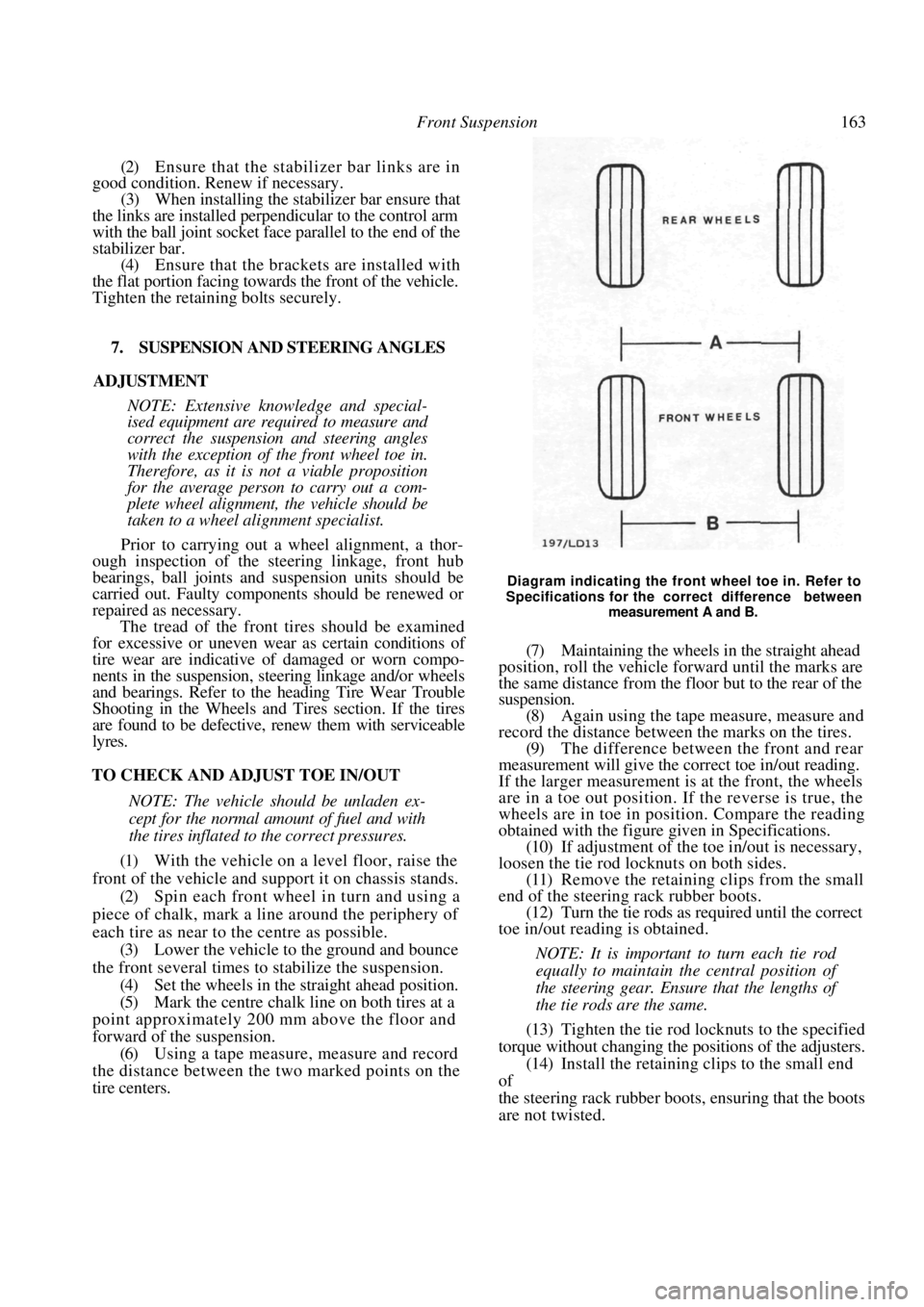
Front Suspension 163
(2) Ensure that the stabilizer bar links are in
good condition. Renew if necessary.
(3) When installing the stabilizer bar ensure that
the links are installed perpendicular to the control arm
with the ball joint socket face parallel to the end of the
stabilizer bar. (4) Ensure that the brackets are installed with
the flat portion facing towards the front of the vehicle.
Tighten the retaining bolts securely.
7. SUSPENSION AND STEERING ANGLES
ADJUSTMENT
NOTE: Extensive knowledge and special-
ised equipment are required to measure and
correct the suspension and steering angles
with the exception of the front wheel toe in.
Therefore, as it is not a viable proposition
for the average person to carry out a com-
plete wheel alignment, the vehicle should be
taken to a wheel alignment specialist.
Prior to carrying out a wheel alignment, a thor-
ough inspection of the steering linkage, front hub
bearings, ball joints and suspension units should be
carried out. Faulty components should be renewed or
repaired as necessary.
The tread of the front ti res should be examined
for excessive or uneven wear as certain conditions of
tire wear are indicative of damaged or worn compo-
nents in the suspension, stee ring linkage and/or wheels
and bearings. Refer to the heading Tire Wear Trouble
Shooting in the Wheels and Tires section. If the tires
are found to be defective, renew them with serviceable
lyres.
TO CHECK AND ADJUST TOE IN/OUT
NOTE: The vehicle s hould be unladen ex-
cept for the normal amount of fuel and with
the tires inflated to the correct pressures.
(1) With the vehicle on a level floor, raise the
front of the vehicle and s upport it on chassis stands.
(2) Spin each front wheel in turn and using a
piece of chalk, mark a line around the periphery of
each tire as near to the centre as possible. (3) Lower the vehicle to the ground and bounce
the front several times to stabilize the suspension. (4) Set the wheels in the straight ahead position.
(5) Mark the centre chalk line on both tires at a
point approximately 200 mm above the floor and
forward of the suspension. (6) Using a tape measure, measure and record
the distance between the two marked points on the
tire centers.
Diagram indicating the front wheel toe in. Refer to
Specifications for the correct difference between
measurement A and B.
(7) Maintaining the wheels in the straight ahead
position, roll the vehicle forward until the marks are
the same distance from the floor but to the rear of the
suspension. (8) Again using the tape measure, measure and
record the distance between the marks on the tires.
(9) The difference between the front and rear
measurement will give the correct toe in/out reading.
If the larger measurement is at the front, the wheels
are in a toe out position. If the reverse is true, the
wheels are in toe in position. Compare the reading
obtained with the figure given in Specifications.
(10) If adjustment of the to e in/out is necessary,
loosen the tie rod locknuts on both sides. (11) Remove the retaining clips from the small
end of the steering rack rubber boots. (12) Turn the tie rods as required until the correct
toe in/out reading is obtained.
NOTE: It is important to turn each tie rod
equally to maintain the central position of
the steering gear. Ensure that the lengths of
the tie rods are the same.
(13) Tighten the tie rod locknuts to the specified
torque without changing the positions of the adjusters.
(14) Install the retaining clips to the small end
of
the steering rack rubber boots, ensuring that the boots
are not twisted.
Page 164 of 238
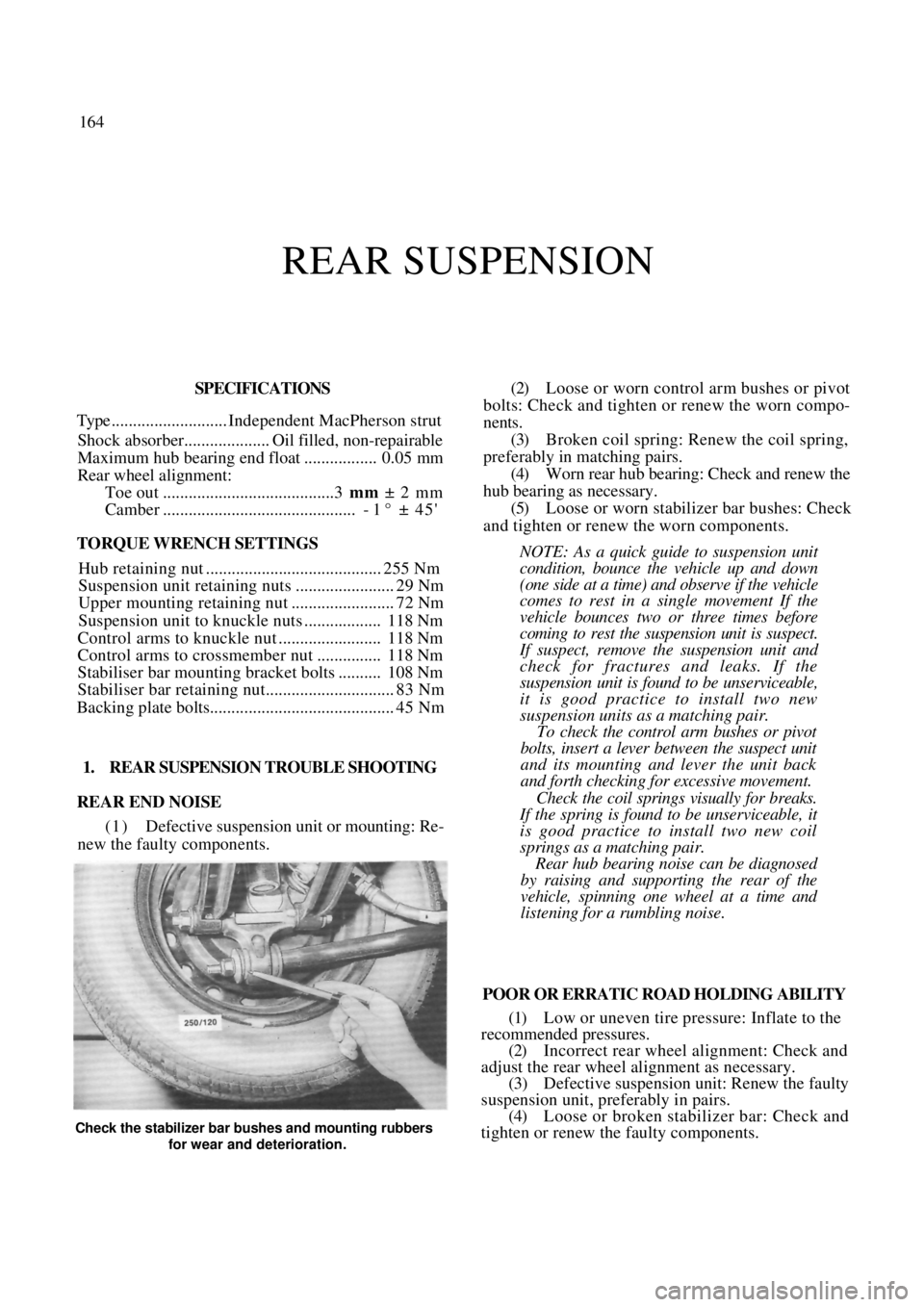
164
REAR SUSPENSION
SPECIFICATIONS
Type........................... Independent MacPherson strut
Shock absorber.................... Oil filled, non-repairable
Maximum hub bearing end float ................. 0.05 mm
Rear wheel alignment:
Toe out ........................................3 mm ± 2 mm
Camber ............................................. - 1 ° ± 4 5 '
TORQUE WRENCH SETTINGS
Hub retaining nut ......................................... 255 Nm
Suspension unit retaining nuts ....................... 29 Nm
Upper mounting retaining nut ........................ 72 Nm
Suspension unit to knuckle nuts .................. 118 Nm
Control arms to knuckle nut ........................ 118 Nm
Control arms to crossmember nut ............... 118 Nm
Stabiliser bar mounting bracket bolts .......... 108 Nm
Stabiliser bar retaining nut.............................. 83 Nm
Backing plate bolts........................................... 45 Nm
1. REAR SUSPENSION TROUBLE SHOOTING
REAR END NOISE
( 1 ) Defective suspension unit or mounting: Re-
new the faulty components.
(2) Loose or worn control arm bushes or pivot
bolts: Check and tighten or renew the worn compo-
nents. (3) Broken coil spring: Renew the coil spring,
preferably in matching pairs. (4) Worn rear hub bearing: Check and renew the
hub bearing as necessary. (5) Loose or worn stabilizer bar bushes: Check
and tighten or renew the worn components.
NOTE: As a quick guide to suspension unit
condition, bounce the vehicle up and down
(one side at a time) and observe if the vehicle
comes to rest in a single movement If the
vehicle bounces two or three times before
coming to rest the susp ension unit is suspect.
If suspect, remove the suspension unit and
check for fractures and leaks. If the
suspension unit is found to be unserviceable,
it is good practice to install two new
suspension units as a matching pair.
To check the control arm bushes or pivot
bolts, insert a lever between the suspect unit
and its mounting and lever the unit back
and forth checking for excessive movement.
Check the coil springs visually for breaks.
If the spring is found to be unserviceable, it
is good practice to install two new coil
springs as a matching pair.
Rear hub bearing noise can be diagnosed
by raising and supporting the rear of the
vehicle, spinning one wheel at a time and
listening for a rumbling noise.
POOR OR ERRATIC ROAD HOLDING ABILITY
(1) Low or uneven tire pressure: Inflate to the
recommended pressures.
(2) Incorrect rear wheel alignment: Check and
adjust the rear wheel alignment as necessary.
(3) Defective suspension unit: Renew the faulty
suspension unit, preferably in pairs. (4) Loose or broken stabilizer bar: Check and
tighten or renew the faulty components.
Check the stabilizer bar bushes and mounting rubbers
for wear and deterioration.
Page 165 of 238
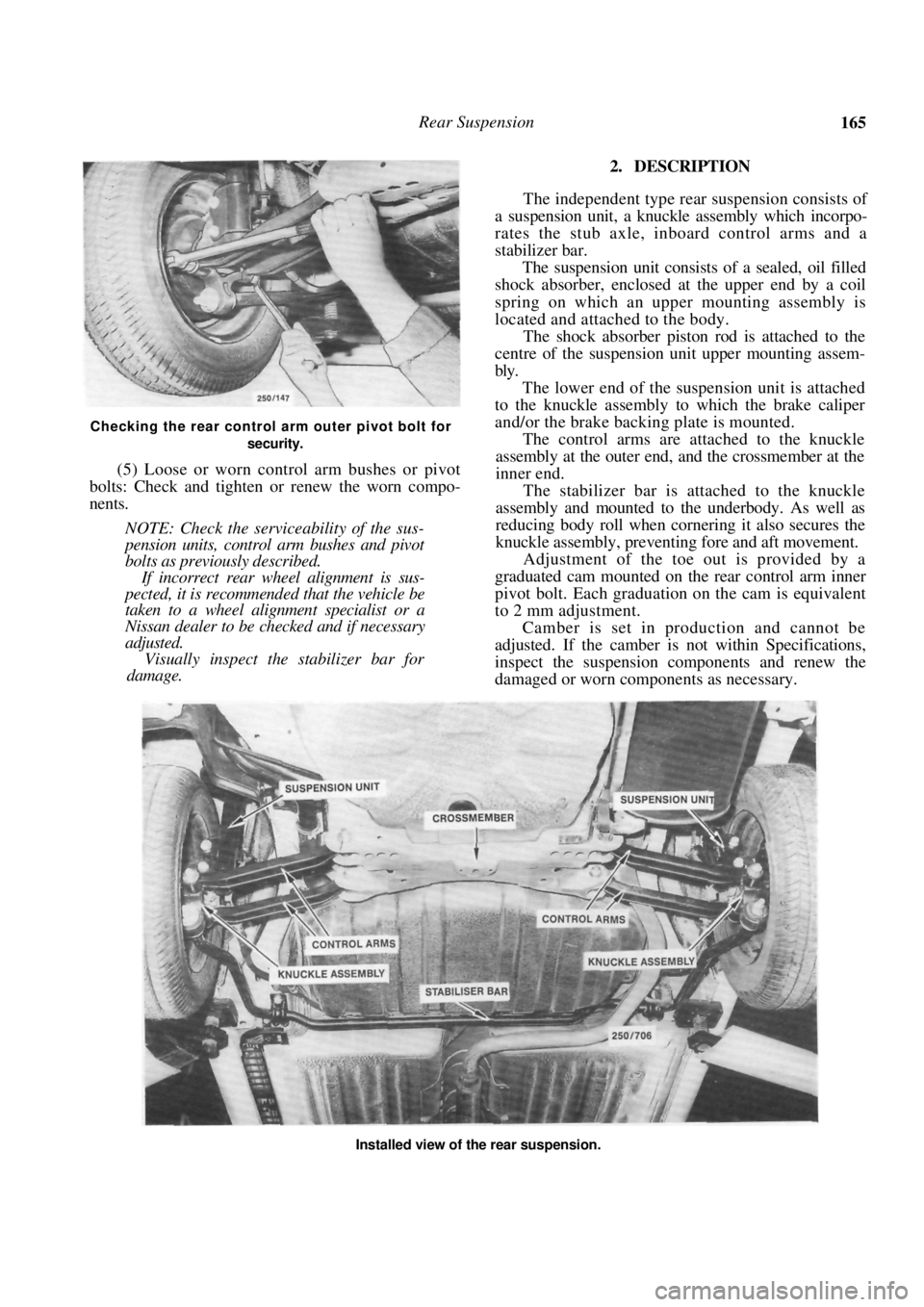
Rear Suspension 165
Checking the rear control arm outer pivot bolt for security.
(5) Loose or worn control arm bushes or pivot
bolts: Check and tighten or renew the worn compo-
nents.
NOTE: Check the service ability of the sus-
pension units, control arm bushes and pivot
bolts as previously described.
If incorrect rear wheel alignment is sus-
pected, it is recommended that the vehicle be
taken to a wheel alignment specialist or a
Nissan dealer to be checked and if necessary
adjusted.
Visually inspect the stabilizer bar for
damage.
2. DESCRIPTION
The independent type rear suspension consists of
a suspension unit, a knuckle assembly which incorpo-
rates the stub axle, inboard control arms and a
stabilizer bar.
The suspension unit consists of a sealed, oil filled
shock absorber, enclosed at the upper end by a coil
spring on which an upper mounting assembly is
located and attached to the body.
The shock absorber piston rod is attached to the
centre of the suspension unit upper mounting assem-
bly.
The lower end of the suspension unit is attached
to the knuckle assembly to which the brake caliper
and/or the brake backing plate is mounted.
The control arms are attached to the knuckle
assembly at the outer end, and the crossmember at the
inner end.
The stabilizer bar is attached to the knuckle
assembly and mounted to the underbody. As well as
reducing body roll when cornering it also secures the
knuckle assembly, preventing fore and aft movement.
Adjustment of the toe out is provided by a
graduated cam mounted on the rear control arm inner
pivot bolt. Each graduation on the cam is equivalent
to 2 mm adjustment.
Camber is set in production and cannot be
adjusted. If the camber is not within Specifications,
inspect the suspension components and renew the
damaged or worn components as necessary.
Installed view of the rear suspension.
Page 166 of 238
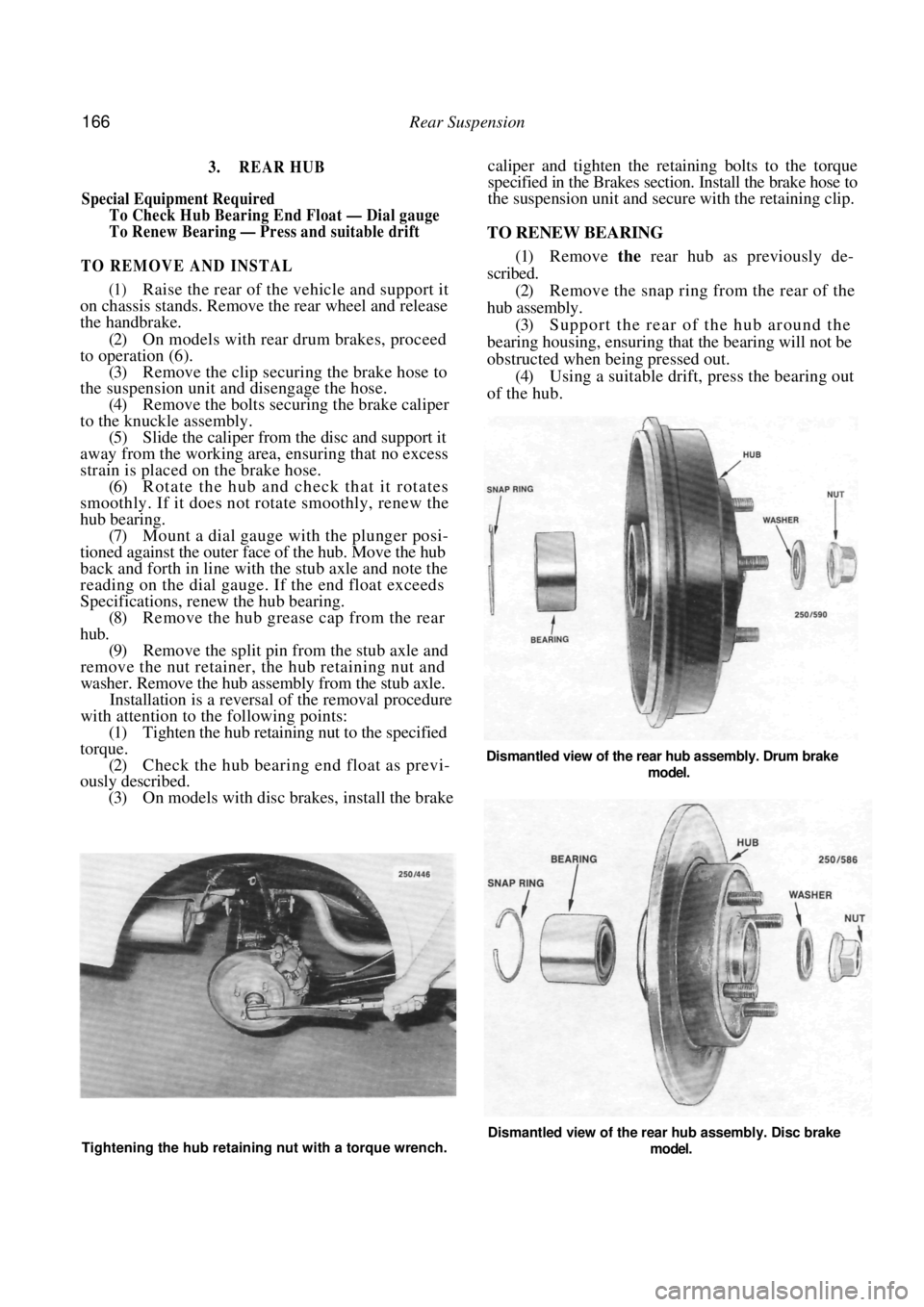
166 Rear Suspension
3. REAR HUB
Special Equipment Required
To Check Hub Bearing End Float — Dial gauge
To Renew Bearing — Press and suitable drift
TO REMOVE AND INSTAL
(1) Raise the rear of the vehicle and support it
on chassis stands. Remove the rear wheel and release
the handbrake.
(2) On models with rear drum brakes, proceed
to operation (6).
(3) Remove the clip securing the brake hose to
the suspension unit and disengage the hose.
(4) Remove the bolts securing the brake caliper
to the knuckle assembly. (5) Slide the caliper from the disc and support it
away from the working area, ensuring that no excess
strain is placed on the brake hose. (6) Rotate the hub and check that it rotates
smoothly. If it does not rotate smoothly, renew the
hub bearing. (7) Mount a dial gauge with the plunger posi-
tioned against the outer face of the hub. Move the hub
back and forth in line with the stub axle and note the
reading on the dial gauge. If the end float exceeds
Specifications, renew the hub bearing.
(8) Remove the hub grease cap from the rear
hub. (9) Remove the split pin from the stub axle and
remove the nut retainer, the hub retaining nut and
washer. Remove the hub assembly from the stub axle. Installation is a reversal of the removal procedure
with attention to the following points:
(1) Tighten the hub retaining nut to the specified
torque. (2) Check the hub bearing end float as previ-
ously described.
(3) On models with disc brakes, install the brake
caliper and tighten the retaining bolts to the torque
specified in the Brakes section. Install the brake hose to
the suspension unit and secure with the retaining clip.
TO RENEW BEARING
(1) Remove the rear hub as previously de-
scribed. (2) Remove the snap ring from the rear of the
hub assembly. (3) Support the rear of the hub around the
bearing housing, ensuring that the bearing will not be
obstructed when being pressed out. (4) Using a suitable drift, press the bearing out
of the hub.
Dismantled view of the rear hub assembly. Drum brake
model.
Tightening the hub retaining nut with a torque wrench. Dismantled view of the rear hub assembly. Disc brake
model.
Page 167 of 238

Rear Suspension 167
NOTE: When a wheel bearing has been
removed from the hub it must be renewed.
(5) Press the new bearing into the hub, ensuring
that pressure is not exerted on the inner race of the
bearing and that the bearin g seal is not damaged. Do
not apply grease or oil to the mating surfaces of the
bearing and the hub.
NOTE: When installing the new bearing,
the press load must not exceed 3 tonnes.
(6) Inspect the snap ring for wear or cracks and
renew as necessary. Install the snap ring into the hub
ensuring that it is secur ely located in the groove.
(7) Apply multi-purpose grease to the bearing
sealing lip and install the hub as previously described.
4. SUSPENSION UNIT
Special Equipment Required:
To Dismantle — Spring compressor
TO REMOVE AND DISMANTLE
(1) On hatchback models, remove the rear par-
cel shelf and lower the rear seat backrests. Remove the
parcel shelf side panel re taining screws and remove
the relevant side panel.
(2) On sedan models, prise out the parcel shelf
retaining buttons using a suitable instrument and
withdraw the parcel shelf from the vehicle. If the rear
radio speakers are installed, remove the speaker grille
retaining screws and separate the speaker grilles from
the speakers prior to withdrawing the parcel shelf
from the vehicle. (3) Raise the rear of the vehicle and support it
on chassis stands as describe d in the Wheels and Tires
section. Remove the rear wheel from the vehicle.
View of the suspension unit with the spring compres-
sors installed.
(4) Remove the clip securing the brake hose to
the suspension unit and disengage the hose from the
suspension unit. (5) Support the weight of the knuckle assembly
and remove the bolts and nuts securing the suspension
unit to the knuckle assembly.
(6) Remove the nuts securing the suspension
unit to the body panel and maneuver the suspension
unit from the vehicle. (7) Thoroughly clean the suspension unit and
secure it in a soft jawed vice.
(8) Remove the dust cap from the upper mount-
ing and while holding the end of the piston rod with
an adjustable spanner, loosen the upper mounting
retaining nut. Do not re move the retaining nut.
(9) Using a suitable spring compressor, com-
press the coil spring and remove the upper mounting
retaining nut and washer. (10) Remove the upper mounting, insulator and
spring seat from th e suspension unit.
(11) Withdraw the upper insulator, coil spring,
lower insulator and dust cover from the suspension
unit. (12) Check the coil spring for cracks, deformation
and damage. Compare the free length with a new coil
spring and renew as necessary.
Location of the suspension unit retaining nuts. Hatch-
back model.
Page 168 of 238

168 Rear Suspension
NOTE: If a coil spring is defective it is
advisable to renew both coil springs as a
matched set.
(13) Check the spring seat for cracks, deforma-
tion or wear and renew as necessary.
(14) Check the upper mounting and the insulator
for wear, damage, signs of melting rubber or deterio-
ration. (15) Check that the piston rod is not cracked,
bent or damaged.
Dismantled view of the suspension unit.
(16 ) Check the hydraulic operation of the suspen-
sion unit. With the suspension unit vertical, move the
piston rod up and down severa l times. A firm pressure
with no slack spots should be evident in both direc-
tions. Also check the suspen sion unit for fluid leakage.
If fluid leakage is present, renew the suspension unit,
preferably in pairs.
TO ASSEMBLE AND INSTAL
Assembly is a reversal of the dismantling proce-
dure with attention to the following points:
(1) Install the coil spring and lower insulator to
the suspension unit ensuring th at the flat end of the
spring is positioned at the top and the lower end of the
spring is located correctly in the suspension unit.
(2) Install the remaining co mponents to the sus-
pension unit, ensuring that the arrow on the spring
seat will be facing the stub axle when installed.
(3) Install a new upper mounting retaining nut,
tighten to the specified tor que and remove the spring
compressor. (4) Position the suspension unit inside the rear
wheel housing and maneuver the mounting studs
into position. With the aid of an assistant, install the
suspension unit retaining nuts and tighten to the
specified torque.
View of the suspension unit removed from the vehicle.
(5) Install the bolts securin g the suspension unit
to the knuckle assembly and tighten the nuts to the
specified torque.
(6) Install the brake hose to the suspension unit
and secure with the retaining clip. (7) Install the rear wheel and lower the vehicle to
the ground. (8) On hatchback models, install the parcel shelf
side panel and the parcel shelf. (9) On sedan models, install the parcel shelf and
insert the retaining buttons firmly. If removed, install
the radio speaker grilles.
Page 169 of 238
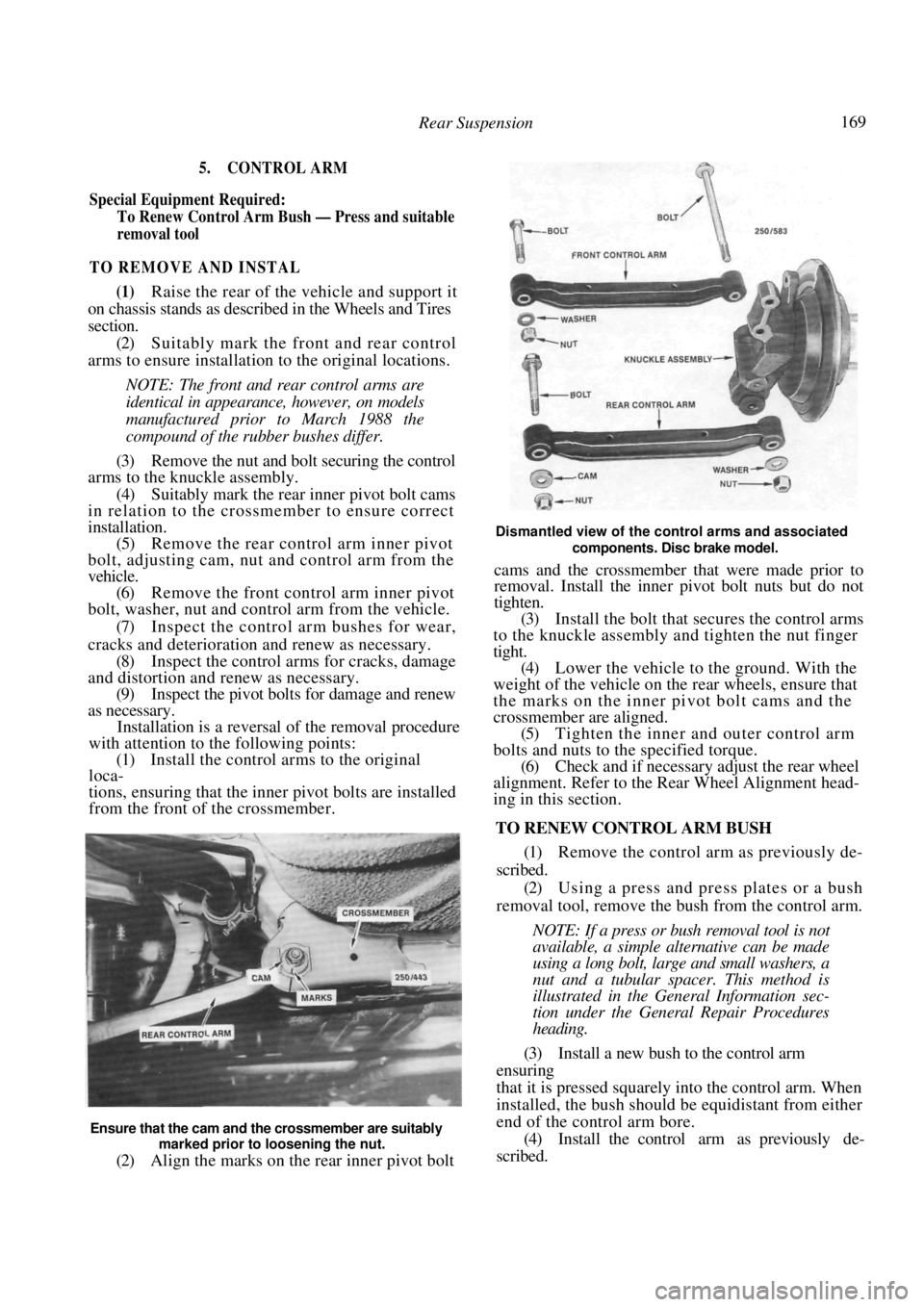
Rear Suspension 169
5. CONTROL ARM
Special Equipment Required:
To Renew Control Arm Bush — Press and suitable
removal tool
TO REMOVE AND INSTAL
(1) Raise the rear of the vehicle and support it
on chassis stands as describe d in the Wheels and Tires
section.
(2) Suitably mark the front and rear control
arms to ensure installation to the original locations.
NOTE: The front and rear control arms are
identical in appearance, however, on models
manufactured prior to March 1988 the
compound of the rubber bushes differ.
(3) Remove the nut and bolt securing the control
arms to the knuckle assembly.
(4) Suitably mark the rear inner pivot bolt cams
in relation to the crossmember to ensure correct
installation.
(5) Remove the rear control arm inner pivot
bolt, adjusting cam, nut and control arm from the
vehicle. (6) Remove the front control arm inner pivot
bolt, washer, nut and control arm from the vehicle.
(7) Inspect the control arm bushes for wear,
cracks and deterioration and renew as necessary. (8) Inspect the control arms for cracks, damage
and distortion and renew as necessary.
(9) Inspect the pivot bolts for damage and renew
as necessary. Installation is a reversal of the removal procedure
with attention to the following points:
(1) Install the control arms to the original
loca-
tions, ensuring that the inner pivot bolts are installed
from the front of the crossmember.
(2) Align the marks on the rear inner pivot bolt
Dismantled view of the control arms and associated
components. Disc brake model.
cams and the crossmember that were made prior to
removal. Install the inner pivot bolt nuts but do not
tighten.
(3) Install the bolt that secures the control arms
to the knuckle assembly and tighten the nut finger
tight. (4) Lower the vehicle to the ground. With the
weight of the vehicle on th e rear wheels, ensure that
the marks on the inner pivot bolt cams and the
crossmember are aligned. (5) Tighten the inner and outer control arm
bolts and nuts to the specified torque. (6) Check and if necessary adjust the rear wheel
alignment. Refer to the Re ar Wheel Alignment head-
ing in this section.
TO RENEW CONTROL ARM BUSH
(1) Remove the control arm as previously de-
scribed. (2) Using a press and press plates or a bush
removal tool, remove the bush from the control arm.
NOTE: If a press or bush removal tool is not
available, a simple alternative can be made
using a long bolt, large and small washers, a
nut and a tubular spacer. This method is
illustrated in the General Information sec-
tion under the General Repair Procedures
heading.
(3) Install a new bush to the control arm
ensuring
that it is pressed squarely into the control arm. When
installed, the bush should be equidistant from either
end of the control arm bore. (4) Install the control arm as previously de-
scribed.
Ensure that the cam and the crossmember are suitably
marked prior to loosening the nut.
Page 170 of 238
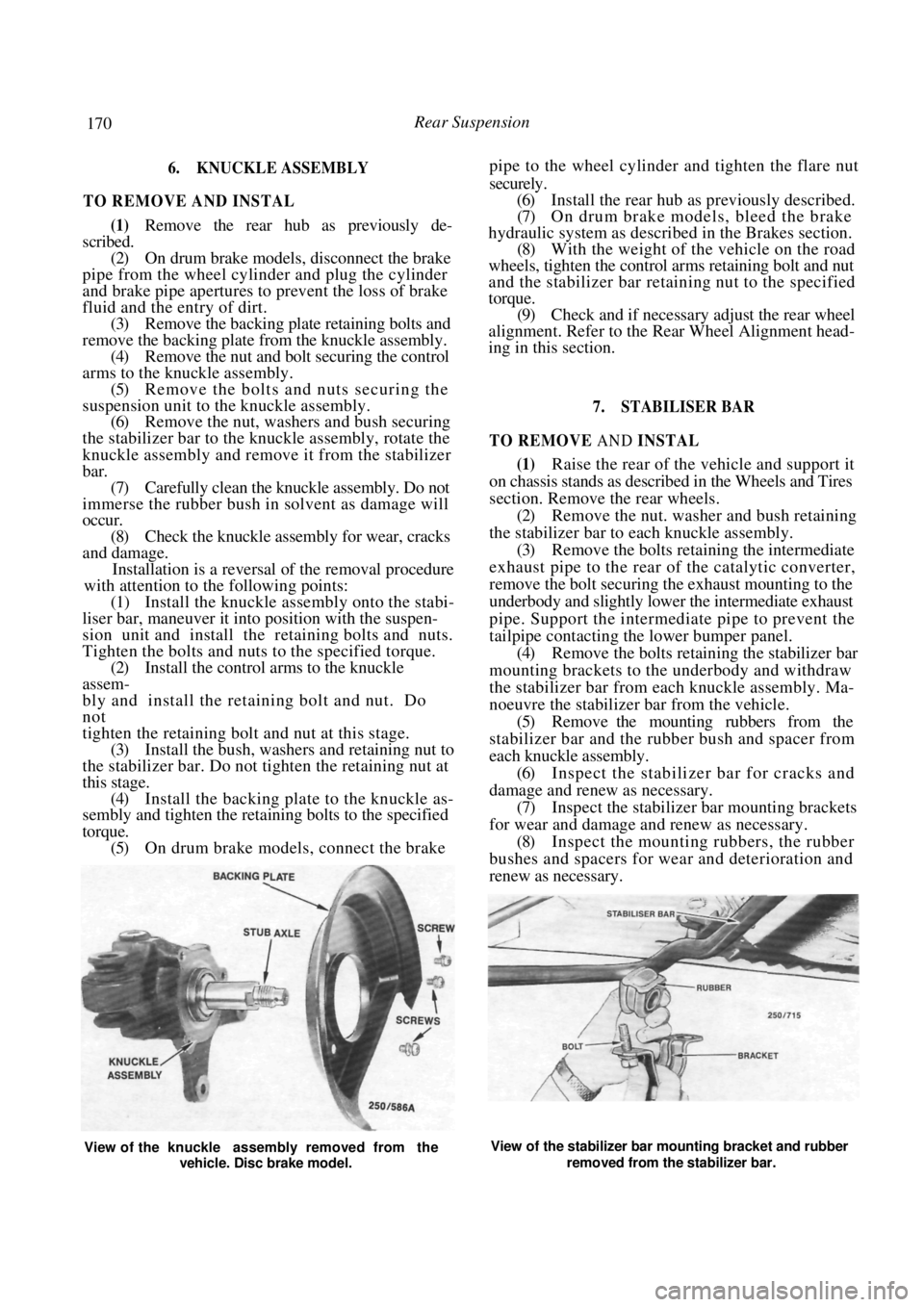
170 Rear Suspension
6. KNUCKLE ASSEMBLY
TO REMOVE AND INSTAL
(1) Remove the rear hub as previously de-
scribed.
(2) On drum brake models, disconnect the brake
pipe from the wheel cylinder and plug the cylinder
and brake pipe apertures to prevent the loss of brake
fluid and the entry of dirt. (3) Remove the backing plate retaining bolts and
remove the backing plate from the knuckle assembly. (4) Remove the nut and bolt securing the control
arms to the knuckle assembly. (5) Remove the bolts and nuts securing the
suspension unit to the knuckle assembly. (6) Remove the nut, washers and bush securing
the stabilizer bar to the knuckle assembly, rotate the
knuckle assembly and remove it from the stabilizer
bar. (7) Carefully clean the knuckle assembly. Do not
immerse the rubber bush in solvent as damage will
occur.
(8) Check the knuckle assembly for wear, cracks
and damage. Installation is a reversal of the removal procedure
with attention to the following points:
(1) Install the knuckle assembly onto the stabi-
liser bar, maneuver it into position with the suspen-
sion unit and install the retaining bolts and nuts.
Tighten the bolts and nuts to the specified torque.
(2) Install the control arms to the knuckle
assem-
bly and install the retaining bolt and nut. Do
not
tighten the retaining bolt and nut at this stage. (3) Install the bush, washers and retaining nut to
the stabilizer bar. Do not tighten the retaining nut at
this stage. (4) Install the backing plate to the knuckle as-
sembly and tighten the retaining bolts to the specified
torque.
(5) On drum brake models, connect the brake
pipe to the wheel cylinder and tighten the flare nut
securely.
(6) Install the rear hub as previously described.
(7) On drum brake models, bleed the brake
hydraulic system as described in the Brakes section.
(8) With the weight of the vehicle on the road
wheels, tighten the control arms retaining bolt and nut
and the stabilizer bar retaining nut to the specified
torque. (9) Check and if necessary adjust the rear wheel
alignment. Refer to the Re ar Wheel Alignment head-
ing in this section.
7. STABILISER BAR
TO REMOVE AND INSTAL
(1) Raise the rear of the vehicle and support it
on chassis stands as describe d in the Wheels and Tires
section. Remove the rear wheels.
(2) Remove the nut. washer and bush retaining
the stabilizer bar to each knuckle assembly. (3) Remove the bolts retain ing the intermediate
exhaust pipe to the rear of the catalytic converter,
remove the bolt securing the exhaust mounting to the
underbody and slightly lower the intermediate exhaust
pipe. Support the intermediate pipe to prevent the
tailpipe contacting the lower bumper panel. (4) Remove the bolts retaining the stabilizer bar
mounting brackets to the underbody and withdraw
the stabilizer ba r from each knuckle assembly. Ma-
noeuvre the stabilizer bar from the vehicle.
(5) Remove the mounting rubbers from the
stabilizer bar and the rubber bush and spacer from
each knuckle assembly. (6) Inspect the stabilizer bar for cracks and
damage and renew as necessary. (7) Inspect the stabilizer bar mounting brackets
for wear and damage and renew as necessary. (8) Inspect the mounting rubbers, the rubber
bushes and spacers for wear and deterioration and
renew as necessary.
View of the knuckle assembly removed from the
vehicle. Disc brake model. View of the stabilizer bar mounting bracket and rubber
removed from the stabilizer bar.